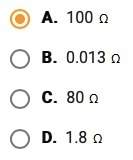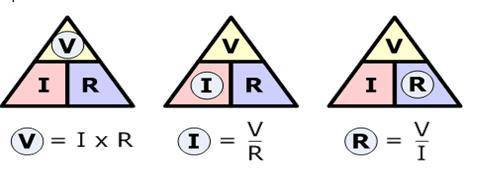
Physics, 26.06.2019 15:00 Queenbabybunnyboo
The voltage in a lightbulb is given by the equation v = ir. in this equation, v is the voltage, i is the current, and r is the resistance. what is the resistance in a lightbulb with a voltage of 12 v and a current of 0.15 a? a. 100 b. 0.013 c. 80 d. 1.8


Answers: 1


Other questions on the subject: Physics

Physics, 22.06.2019 01:00, KenzieD7876
Need asap ! what is the relationship between atmospheric pressure and the density of gas particles in an area of increasing pressure? (2 points) as air pressure in an area increases, the density of the gas particles in that area decreases. as air pressure in an area increases, the density of the gas particles in that area increases. as air pressure in an area increases, the density of the gas particles in that area remains constant. as air pressure in an area increases, the density of the gas particles in that area increases and decreases in an alternating pattern. 3. which of the following correctly describes a way in which earth's atmosphere interacts with the geosphere? (2 points) it contains gases that living organisms breathe. it contains gases that trap incoming solar radiation. it provides a medium for cycles that provide nutrients to living organisms. it provides a medium for water to move between earth's surface and the air. 4. which of the following is considered a drawback to using wind energy as a source of power? (2 points) wind energy is nonrenewable. wind energy produces large amounts of air pollution. 5. a meteorologist predicts that the weather in a region will soon change from clear skies to probable thunderstorms. prior to making this prediction, what did the meteorologist most likely observe on a barometer? (2 points) the barometer fell slightly. the barometer fell substantially. the barometer rose slightly. the barometer rose substantially. 6. which of the following do meteorologists not typically use weather balloons to record? (2 points) atmospheric pressure cloud types humidity temperature 7. during which step in the can crush lab did water vapor force air from the can? (2 points) the can was filled nearly to the top with water. the can was placed on the hot stove top burner for several minutes. the can was removed from the hot stove top burner. the can was placed upside-down in the water-filled pan.
Answers: 2

Physics, 22.06.2019 10:00, lorelei7668
(a) calculate the number of electrons in a small, electrically neutral silver pin that has a mass of 10.0 g. silver has 47 electrons per atom, and its molar mass is 107.87 g/mol. (b) imagine adding electrons to the pin until the negative charge has the very large value 1.00 mc. how many electrons are added for every 109 electrons already present
Answers: 3

Physics, 22.06.2019 14:10, momo842
Your starship, the aimless wanderer, lands on the mysterious planet mongo. as chief scientist-engineer, you make the following measurements: a 2.50-kg stone thrown upward from the ground at 14.0 m/s returns to the ground in 5.70 s ; the circumference of mongo at the equator is 2.20×10^5 km ; and there is no appreciable atmosphere on mongo. (a) the starship commander, captain confusion, asks for the following information: what is the mass of mongo? (b) if the aimless wanderer goes into a circular orbit 2.20×10^4 km above the surface of mongo, how many hours will it take the ship to complete one orbit? (c) an unmanned spacecraft is in a circular orbit around the moon, observing the lunar surface from an altitude of 44.0 km . to the dismay of scientists on earth, an electrical fault causes an on-board thruster to fire, decreasing the speed of the spacecraft by 23.0 m/s . if nothing is done to correct its orbit, with what speed (in km/h) will the spacecraft crash into the lunar surface?
Answers: 1

Physics, 22.06.2019 17:00, griffinkiley22
Two manned satellites approaching one another at a relative speed of 0.550 m/s intend to dock. the first has a mass of 2.50 ✕ 103 kg, and the second a mass of 7.50 ✕ 103 kg. assume that the positive direction is directed from the second satellite towards the first satellite. (a) calculate the final velocity after docking, in the frame of reference in which the first satellite was originally at rest.(b) what is the loss of kinetic energy in this inelastic collision? (c) repeat both parts, in the frame of reference in which the second satellite was originally at rest. final velocity(d) loss of kinetic energy = ?
Answers: 2
You know the right answer?
The voltage in a lightbulb is given by the equation v = ir. in this equation, v is the voltage, i is...
Questions in other subjects:

Social Studies, 05.05.2020 07:12


Mathematics, 05.05.2020 07:12

Social Studies, 05.05.2020 07:12











